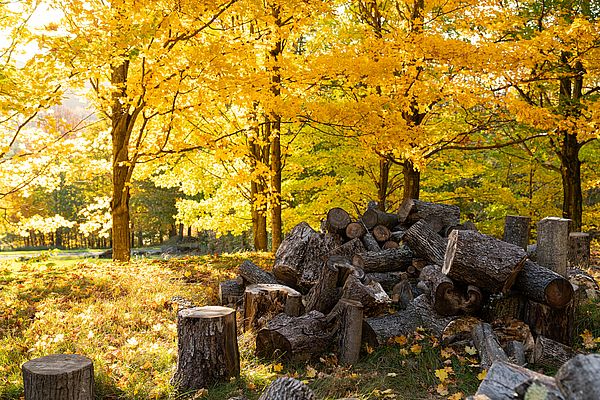At this time of year, I daydream of swimming in lakes and camping under the stars. My garden is planted, I'm harvesting spinach, and my kids are rejoicing over the opening of the local creemee stand. It’s not the time of year when I spend a lot of time thinking about wood stoves and home heating systems.
But perhaps I should. It’s a bit like the old joke, I suppose:
Person #1: So… when are you planning to fix your leaky roof?
Person #2: Well, when it’s raining, it’s too wet to fix, and when it’s dry this roof is as good as any!
Winter may be when we need the heat, but it’s not the best time to be looking at heating systems. And so, I bring you some resources now, in June.
Some of you may have attended the webinar Cold Hollow to Canada hosted in March, with guest speakers Emma Hanson and Gail Stevenson. For those who missed it, the recorded program can still be viewed, at this link. I’ll review some of Emma and Gail’s top points here, too.
Gail Stevenson is the Executive Director of BurnRight Vermont, an organization dedicated to educating Vermonters about building better fires. By “better,” think “more heat, less money, and better for the environment.” BurnRight’s solutions are amazingly simple, too. The organization promotes just 5 simple steps for accomplishing their goals:
- Burn the right fuel. Make sure it’s dry!
- Flip your fire upside down. BurnRight has a full page on how to do this, but the basic idea is to put the large logs on the bottom, place the smaller logs and kindling in the middle, and then light it from the top. They encourage the use of a fire starter rather than using the classic newspaper that emits more smoke and particulates as it burns. This top-down approach creates a better draft and less smoke!
- Keep the fire burning hot. A hot fire is more efficient.
- Check out the color of the smoke. A clean-burning fire emits very little smoke. Black or yellow smoke is a clue that your fire isn’t burning efficiently.
- Use a clean and efficient stove or boiler. Not all stoves are equal in their efficiency, and a new stove may actually save you money over time–in addition to being better for air quality!
You can learn more about all five steps on the BurnRight website.
After Gail’s webinar, I’ve been trying some of these techniques in my own woodstove. In case you’re wondering, I found that the “upside down” fire truly does work, and as promised, it burns nearly smoke-free. That said, I’m still experimenting with fire starters, as they were not part of my previous fire-building routine. (If anyone has recipes for home-made ones that burn cleanly, I’m interested! Recipes I’ve found on the internet tend to call for melted crayons or dryer lint, which I can’t imagine support air quality improvement goals.)
Here’s where the month of June comes back in: It’s campfire season, and while not all of these techniques are relevant in an outdoor setting, it seems a good chance to practice my upside-down fire building skills–in a campfire pit, where I have a bit more space to play with and can directly see my results. I look forward to a bit of experimentation with smoke color, too. With the woodstove, I sometimes find it easier to examine the color of my neighbor’s smoke than my own!
In addition to campfire experimentation, those in the market for a new home heating system may be interested in a few of the ideas from Emma Hanson’s portion of the March webinar, too. Emma is the Wood Energy Coordinator with Vermont Department of Forests, Parks, and Recreation, and she has a wealth of knowledge when it comes to understanding the science behind different home heating systems. In her webinar, she shared comparisons of the particulate matter emitted from different heating systems, cost comparisons over time, and the interplay between wood heating systems and Vermont’s forest health and renewable energy goals. If you’re someone who likes to see data-driven information on wood energy, Emma supported her talk with graphs and charts that are well worth checking out.
In particular, Emma spoke about a relatively new option on the market: Automated Wood Heat. This is for those who want to heat with wood and who also enjoy the simplicity of home heat that’s regulated with a thermostat and regular fuel deliveries rather than daily time investment. While I’m very happy with the wood stove/heat pump combination currently in my own home, I can certainly see the appeal of this system, particularly for those looking to simplify. Emma also shared information about the numerous rebates and grants currently available to those ready to invest in a new, cleaner-burning wood energy system. You can learn more through the Department’s website.
Last month, my family started moving the woodpile from our back yard into our garage, where it can continue to season and where we’ll have easy access to it all winter. It’s a process we usually reserve for fall, when we’re dreaming of cozying up by the fire and snuggling with steaming mugs of choice hot beverages. It’s a process also typically accompanied by a feeling of panic. Will we finish before the snow flies? we wonder. Will we have enough to last the winter? This year, we know we can answer a confident “yes” to both questions, leaving the summer as a time to visit swimming holes free of worry, camp under the stars, tend to the garden, visit creemee stands… and practice building campfires.
